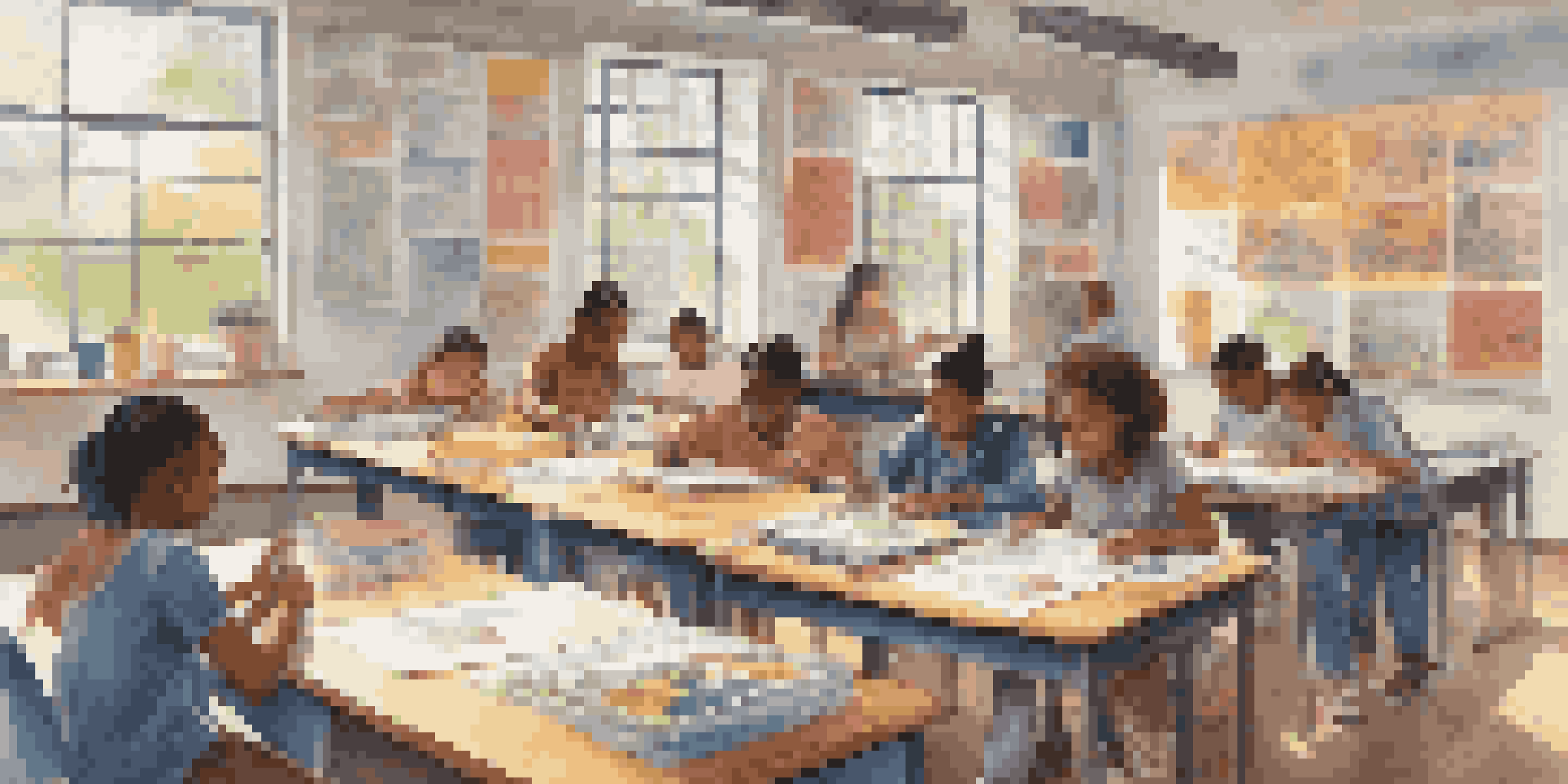Navigating Challenges in Diverse Classrooms with PBL

Understanding the Importance of Diverse Classrooms
Diverse classrooms bring together students from various backgrounds, cultures, and abilities. This rich tapestry can enhance learning, as students share different perspectives and experiences. However, it can also present unique challenges for educators trying to meet the needs of every learner. Understanding and embracing this diversity is crucial for fostering an inclusive environment.
Diversity is the one true thing we all have in common. Celebrate it every day.
For example, consider a classroom where students speak multiple languages. Teachers must find ways to ensure everyone can participate, which may require tailored resources or teaching strategies. This diversity is not just a statistic; it’s an opportunity for growth if approached with the right mindset. Emphasizing the value of each student's contribution can boost engagement and motivation.
Ultimately, recognizing the strengths and challenges of diverse classrooms sets the stage for effective teaching. When educators appreciate the variety of experiences students bring, they can create a more dynamic and responsive learning atmosphere. This understanding is key as we explore how project-based learning (PBL) can help navigate these challenges.
What is Project-Based Learning (PBL)?
Project-Based Learning (PBL) is a teaching method that encourages students to learn by engaging in real-world projects. Rather than traditional rote memorization, PBL fosters critical thinking, collaboration, and creativity. For instance, students might work together to solve a community issue, allowing them to apply their knowledge practically. This hands-on approach can be particularly effective in diverse classrooms.

In a PBL environment, students take charge of their learning, which can help bridge gaps between different abilities and backgrounds. They learn to work in teams, respect diverse viewpoints, and contribute their unique skills. This not only enhances their academic experience but also builds essential life skills. The collaborative nature of PBL allows students to see the value in each other's contributions.
By utilizing PBL, educators can create inclusive experiences that cater to various learning styles. Teachers can scaffold projects to ensure everyone can participate meaningfully, which is essential in diverse settings. This adaptability is one of the many reasons PBL is an effective tool for addressing the challenges of classroom diversity.
Identifying Challenges in Diverse Classrooms
Diverse classrooms come with their own set of challenges, such as language barriers, varied learning styles, and differing cultural backgrounds. These factors can lead to misunderstandings and disengagement if not addressed properly. For instance, a student who struggles with English might feel left out during discussions, impacting their overall learning experience. Identifying these challenges early is essential for creating an effective learning environment.
The only way to do great work is to love what you do.
Additionally, teachers may find it difficult to cater to the varying academic levels within a single classroom. Some students may need more support while others thrive on independence. Balancing these needs can be daunting and requires thoughtful planning and flexibility. Recognizing these differences allows educators to tailor their approaches and ensure all students feel valued.
Ultimately, understanding these challenges is the first step toward finding effective solutions. By being proactive and observant, teachers can create strategies that foster an inclusive atmosphere. This groundwork is vital as we delve into how PBL can address these diverse needs through collaborative projects.
Leveraging PBL to Address Diversity Challenges
Project-Based Learning offers a unique framework for addressing the diverse needs of students in the classroom. It encourages collaboration, allowing students to contribute their strengths while learning from one another. For example, a project might involve students from different backgrounds working together to research a cultural topic, enriching their understanding and appreciation of each other's experiences. This collaborative aspect of PBL is essential for building community among diverse learners.
Moreover, PBL can be adapted to accommodate varying learning styles and paces. Teachers can provide different roles within a project, allowing students to shine in areas where they excel. This not only boosts confidence but also fosters a sense of belonging as students see their contributions matter. When students feel valued, they are more likely to engage fully in their learning.
By leveraging PBL, educators can create a more inclusive environment that respects and celebrates diversity. This method not only meets academic goals but also nurtures social-emotional learning. As we explore specific strategies for implementing PBL in diverse classrooms, it’s clear that the benefits extend far beyond academic achievement.
Strategies for Implementing PBL in Diverse Classrooms
Implementing PBL in diverse classrooms requires intentional strategies that cater to every student's needs. One effective approach is to design projects that are culturally relevant and relatable. This not only sparks interest but also allows students to draw on their backgrounds, making learning more engaging. For example, a project on local history could involve students researching their own family histories, fostering a sense of pride and connection.
Another strategy is to differentiate tasks within a project based on students’ abilities. This might mean assigning leadership roles or specific tasks that align with each student's strengths. By doing so, all students can contribute meaningfully, ensuring that no one feels sidelined. Teachers can also use technology to provide additional resources and support for those who need it.
Lastly, creating a safe environment for sharing ideas is crucial. Encouraging open dialogue allows students to express their thoughts and learn from each other. By implementing these strategies, educators can create a PBL framework that not only addresses academic goals but also nurtures an inclusive classroom culture.
Assessing Student Learning in PBL Environments
Assessing student learning in a PBL environment can be different from traditional assessment methods. Instead of relying solely on tests, educators can use formative assessments that capture students' progress throughout the project. This might include self-reflections, peer evaluations, and teacher observations. Such varied assessment methods provide a more comprehensive view of student understanding and engagement.
Additionally, it’s important to set clear expectations and rubrics from the outset. When students understand what is expected of them, they can take ownership of their learning. These rubrics can be tailored to accommodate different abilities, ensuring fairness in evaluation. For example, a student who excels in creativity might be assessed on their innovative ideas while another focuses on research skills.
By embracing diverse assessment strategies, teachers can gain insights into each student's learning journey. This approach not only celebrates individual achievements but also highlights areas for growth. As we continue to explore the implications of PBL, it becomes clear that assessment plays a pivotal role in fostering a culture of continuous improvement.
Fostering Collaboration Among Students
Collaboration is at the heart of Project-Based Learning, especially in diverse classrooms. Encouraging students to work together not only enhances their understanding of the subject matter but also builds essential interpersonal skills. For instance, when students collaborate on a science project, they learn to communicate effectively, respect differing opinions, and negotiate roles. These skills are invaluable, both in school and beyond.
To foster collaboration, educators can implement group norms and strategies that promote inclusivity. Establishing clear guidelines for teamwork helps ensure that every voice is heard and valued. Additionally, mixing up groups for different projects can expose students to new perspectives and strengthen relationships. This not only enriches the learning experience but also cultivates empathy and understanding among peers.

Ultimately, fostering collaboration among students can lead to a more cohesive classroom environment. When students work together, they build a community of support where learning is a shared journey. As we conclude our exploration of PBL in diverse classrooms, it’s evident that collaboration is key to unlocking the potential of every learner.